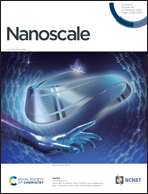Intratumoral injection of hydrogel-embedded nanoparticles enhances retention in glioblastoma†
Abstract
Intratumoral drug delivery is a promising approach for the treatment of glioblastoma multiforme (GBM). However, drug washout remains a major challenge in GBM therapy. Our strategy, aimed at reducing drug clearance and enhancing site-specific residence time, involves the local administration of a multi-component system comprised of nanoparticles (NPs) embedded within a thermosensitive hydrogel (HG). Herein, our objective was to examine the distribution of NPs and their cargo following intratumoral administration of this system in GBM. We hypothesized that the HG matrix, which undergoes rapid gelation upon increases in temperature, would contribute towards heightened site-specific retention and permanence of NPs in tumors. BODIPY-containing, infrared dye-labeled polymeric NPs embedded in a thermosensitive HG (HG–NPs) were fabricated and characterized. Retention and distribution dynamics were subsequently examined over time in orthotopic GBM-bearing mice. Results demonstrate that the HG–NPs system significantly improved site-specific, long-term retention of both NPs and BODIPY, with co-localization analyses showing that HG–NPs covered larger areas of the tumor and the peri-tumor region at later time points. Moreover, NPs released from the HG were shown to undergo uptake by surrounding GBM cells. Findings suggest that intratumoral delivery with HG–NPs has immense potential for GBM treatment, as well as other strategies where site-specific, long-term retention of therapeutic agents is warranted.



 Please wait while we load your content...
Please wait while we load your content...